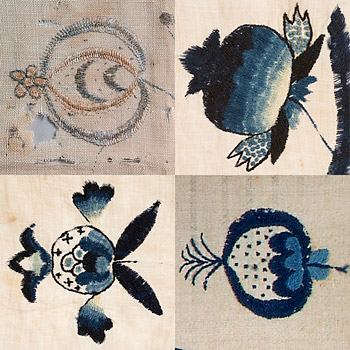Deerfield Arts & Crafts home page
Ideas
The Pomegranate Motif

© Memorial Hall Museum, Pocumtuck Valley Memorial Association
The Colonial Pomegranate
Lucy Lane, detail of bed hangings, c. 1760-65; Rebekah Dickinson, two pomegranate details from her bed hangings, 1765; Elizabeth Reed Pierce, detail from a counterpane, c. 1800
18th Century Fruit
In the early years of their collaboration, Whiting and Miller studied and drew many stylized versions of the pomegranate. They found these in the 18th-century embroideries they sought throughout western Massachusetts. The pomegranate motif appearing at the top left was stitched by Lucy Lane (1752-1803) of Attleboro and Northampton, Massachusetts. By the late 19th century, Lucy's bed hangings were owned by the Memorial Hall Museum and became an early inspiration for Miller and Whiting, who adapted Lane's ideas, in particular her acanthus leaf motif, to their own designs. Rebekah Dickinson's (1738-1813) bed hangings were also studied by the young designers, and Dickinson's imagery also inspired their own. Here are pictured two of the many pomegranates which Dickinson interspersed with vines and stylized flowers over the surface of her work. A final example of an 18th pomegranate, located at the lower right, is that stitched by Elizabeth Reed Pierce of Amherst, Massachusetts. Miller and Whiting likewise studied Reed Pierce's counterpane and adapted her designs into later Deerfield Society of Blue and White Needlework.